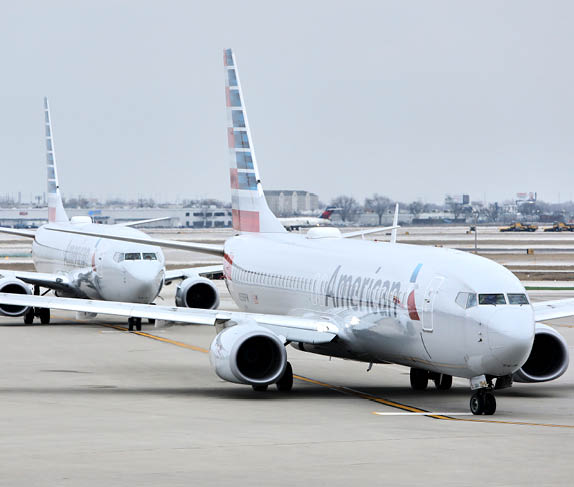Chorus Aviation generated operating income of $26.8 million during the first quarter of 2016, an increase of $10.9 million over first quarter of 2015. This increase was driven by a $1.0 million contribution from the Voyageur operation while aircraft leasing operations under the CPA contributed an additional $5.3 million as a result of the addition of new Q400s in the fourth quarter of 2015 and the first quarter of 2016, combined with a change in the US dollar exchange rate. The remaining net increase of $4.6 million in operating income was primarily attributable to a net decrease in collective agreement signing bonuses of $4.5 million, and other expense reductions.
Adjusted EBITDA in the first quarter of 2016 was $45.4 million, a $17.4 million increase over the first quarter of 2015. This increase resulted primarily from the $10.9 million increase in operating income as well as a net $6.5 million increase in depreciation and amortization expense compared to the first quarter of 2015.
"I am pleased again this quarter to report solid earnings and operational performance by Chorus," said Joe Randell, President and Chief Executive Officer, Chorus. "Quarter-over-quarter we generated increases in operating income and adjusted EBITDA of 69% and 62% respectively, and ended the first quarter of 2016 with net income per basic share of $0.45, or $0.12 per basic share on an adjusted basis."
"The Capacity Purchase Agreement ('CPA') with Air Canada is delivering the strong cash flow and benefits anticipated as evidenced by our solid financial results for the past five quarters," continued Mr. Randell. "The agreement not only preserves the value we had previously established for our shareholders and employees; it also provides a foundation to pursue growth and diversification. We have excellent visibility on our costs and compensation to 2025. Cash flow from this agreement is anticipated to support the current dividend, as well as future investments to support our corporate objectives. Recent initiatives such as the planned acquisition of five new CRJ900 regional jets, the anticipated third-party heavy maintenance contract at Jazz, and our intention to consolidate Chorus' stock ticker symbols are expected to generate positive returns. I thank the Chorus team for helping realize our vision to be a premiere provider of regional airline services."
Operating revenue decreased from $375.1 million to $320.6 million, representing a decrease of $54.6 million, or 14.5%.
Controllable revenue decreased by $8.4 million or 4.2%. The controllable revenue reduction was primarily driven by rate decreases under the CPA related to aircraft lease returns and other reductions in controllable costs, such as flight and cabin crew, which accounted for $8.7 million of the decrease. A further decrease of approximately $6.5 million resulted from 4,729 fewer billable block hours generated in the first quarter of 2016 compared to the same period in 2015. These decreases were offset by a change in the US dollar exchange rate that resulted in a $6.8 million increase in the quarter.
Aircraft leasing revenue under the CPA increased by $7.2 million to $23.2 million. $5.6 million was generated from the addition of new Q400 aircraft to the CPA covered fleet, and $1.6 million of the increase was related to a change in the US dollar exchange rate. As of March 31, 2016, aircraft leasing revenue under the CPA was generated from 28 Q400 aircraft and four Q400 engines owned by Chorus, compared to 21 Q400 aircraft and four Q400s engines owned by Chorus as of March 31, 2015. Annually these aircraft and engines currently generate a cash margin of approximately 20% after consideration of debt servicing charges.
Under the amended CPA, Chorus' compensation is based on fixed fees for the term of the agreement. The fixed fee compensation for the first quarter of 2016 was contractually set at $27.4 million. It is anticipated that when the five incremental Q400 and five incremental CRJ900 aircraft (announced September 28, 2015) are operating in the CPA fleet, the annual fixed fee compensation will increase to $111.7 million, or $27.9 million quarterly until 2020.
In the first quarter, Chorus earned $5.7 million in performance incentives, or 96.7% of the maximum incentive payment available under the CPA, compared to $5.6 million or 96.7% in the first quarter of 2015.
CPA pass-through revenue decreased by $66.5 million or 53.9%, from $123.4 million to $56.9 million. Compensation for aircraft fuel (effective November 1, 2015), deicing and certain other costs provided to Chorus by Air Canada are no longer billed. Further, effective January 1, 2016, Air Canada entered into a new commercial agreement with the Vancouver International Airport Authority ('YVR') in connection with Jazz's CPA operations. YVR costs related to airport fees and certain terminal handling services, which are pass-through costs under the CPA, are now paid directly by Air Canada pursuant to this new agreement. This change accounted for a $4.8 million decrease in CPA pass-through revenue.
Charter and other contract flying revenue increased by $10.1 million to $11.2 million. Contract flight revenue from the Voyageur operation accounted for $9.9 million of the increase.
Other revenue increased by $2.9 million to $6.5 million. Revenue from the Voyageur operation, which includes maintenance repair and overhaul and leasing, accounted for $5.3 million; offset by decreased ancillary revenue and decreased sale of consignment inventory of $2.4 million.
Operating expenses decreased from $359.2 million to $293.8 million, a decrease of $65.5 million or 18.2%.
Salaries, wages and benefits decreased by $2.1 million to $116.0 million. Adjusted salaries, wages and benefits increased by $4.3 million primarily as a result of the Voyageur operation. As part of the newly ratified collective agreement with Jazz maintenance and engineering employees, Chorus incurred a $5.5 million one-time signing bonus in 2016, while in the first quarter of 2015, Chorus incurred a $10.0 million one-time signing bonus with Jazz pilots as part of the newly ratified collective agreement. This accounted for a net decrease of $4.5 million. Stock-based compensation decreased primarily as a result of fluctuations in Chorus' share price.
Depreciation and amortization expense increased by $6.5 million to $18.6 million. Depreciation expense related to Voyageur was $3.5 million, and the purchase of additional aircraft during the second half of 2015 and the first quarter of 2016 accounted for $1.9 million. Further, depreciation associated with capitalized major maintenance overhauls increased depreciation expense by $0.4 million, and new finance leases accounted for $0.7 million.
Aircraft maintenance expense decreased by $3.1 million to $47.0 million. Compared to first quarter 2015, fewer block hours and fewer engine overhaul events accounted for $1.9 million and $1.2 million decreases respectively. Other maintenance costs decreased by $3.0 million, and decreased cost of sales of consignment inventory accounted for $0.8 million. These decreases were offset by a change in the US dollar exchange rate on certain maintenance material purchases which accounted for a $2.2 million increase, and the Voyageur operation accounted for a $1.6 million increase.
Other expenses increased by $3.9 million to $33.6 million. This increase was due to increased costs from the Voyageur operation of $3.1 million, and increased crew costs related to training and travel associated with the flow of pilots to Air Canada of $1.0 million. These increases were offset by general overhead decreases of $0.2 million.
Non-operating expenses decreased by $70.9 million from an expense of $37.2 million in the first quarter of 2015 to a non-operating income of $33.8 million. Net interest expense increased by $1.7 million. Interest expense related to long-term debt increased by $1.4 million as a result of a change in the US dollar exchange rate, new Q400 long-term debt, and $0.3 million related to interest on consideration payable. The strengthening of the Canadian dollar in the quarter contributed to a foreign exchange gain of $38.8 million, compared to a foreign exchange loss of $33.9 million in the same period of the previous year.
Operating income of $26.8 million increased by $10.9 million from $15.9 million.
Adjusted EBITDA was $45.4 million compared to $28.0 million in 2015, an increase of $17.4 million.
Adjusted net income for the first quarter 2016 was $14.8 million or $0.12 per basic share compared to $8.9 million or $0.07 per basic share for the same period 2015. Net income in the quarter was $55.4 million or $0.45 per basic share compared to a 2015 net loss of $24.8 million or loss of $0.21 per basic share.

